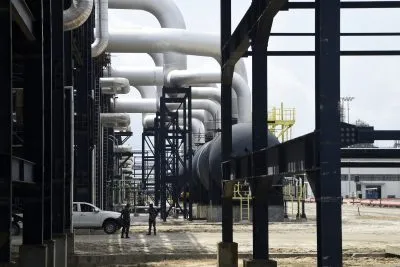At El Dabaa on Egypt’s Mediterranean coast, teams of construction crews are hard at work at the site of what will be the first nuclear power station in Egypt, and only the second in Africa. The facility will eventually host four reactors, supplying 4.8 GW of power to a country that has been struggling to keep the lights on in recent years.
Alongside Arabic, the language most likely to be heard at the construction site is Russian. The power station is being built by Russia’s state-owned nuclear energy company, Rosatom. Rosatom will also supply nuclear fuel to the reactors and will oversee the power station’s day-to-day operations for 10 years while Egyptian personnel are trained. “The plant will be the largest project of Russian-Egyptian cooperation since the Aswan High Dam,” said Alexey Likhachev, Rosatom’s CEO, when construction began last year.
Russia’s growing presence in Africa is reflected in many of the nuclear power projects currently on the drawing board around the continent. Uganda’s President Yoweri Museveni claimed in August to have reached a deal with Russia to construct a nuclear power station. Rosatom has also developed plans for nuclear power in countries including Nigeria and Sudan in recent years, while seeking to win a contract to expand nuclear power in South Africa.
But Russia does not have Africa’s nuclear arena to itself. Companies from various countries are competing to win nuclear deals on the continent, while the US announced funding for nuclear energy in Ghana in September.
Amid the increasingly intense geopolitical competition, the question of whether nuclear energy should have a place in Africa’s energy system remains a matter of fierce debate. In fact, no form of energy is as polarising as nuclear. To its advocates, nuclear energy is the best way to meet Africa’s huge energy needs, while also eliminating carbon emissions. Its critics, on the other hand, insist that nuclear is unaffordable and that its use threatens environmental catastrophe.
The nuclear option
Demands for nuclear energy stem from the reality that Africa, as a whole, suffers from a huge power deficit. Africa has the world’s lowest levels of energy access. Around 600m people in sub-Saharan Africa live without electricity, according to the International Energy Agency.
Countries such as Ghana and Uganda, which are both seriously considering nuclear projects, will see their energy needs increase significantly in the coming years, due to both population growth and industrialisation. Nuclear can be a “win-win for African countries needing energy to industrialise,” says Princess Mthombeni, founder of advocacy group Africa4Nuclear.
Mthombeni argues that renewables, by themselves, are unlikely to be able to provide power on a sufficient scale to enable industrialising African countries to satisfy energy demand in the 2030s and beyond. The continent needs the “fastest route possible” to improving its power supply, she says.
She points to the United Arab Emirates, which began generating power from a nuclear power station in 2020, as an example of how nuclear can transform a power system much more rapidly than incremental additions of wind or solar capacity. The South Korean-built facility has the capacity to supply up to 25% of the UAE’s electricity needs.
Nivedh Thaikoottathil, renewables and power analyst at consulting firm Rystad Energy, notes that the huge investment needed for a conventional nuclear power plant can be spread over the several decades that a facility will be operational. The average lifetime of a nuclear facility is “almost 2.4 times that of solar or wind,” he says.
Another obvious benefit is that nuclear energy generation does not cause carbon emissions (although the construction phase of a project is carbon intensive). And the power supply from nuclear is constant – unlike wind and solar, which can generate electricity only intermittently.
“Nuclear power has the potential to serve as a sustainable source of baseload power – replacing fossil fuels and supporting renewables such as solar, wind and hydro to cater to Africa’s ever-increasing power demand,” says Thaikoottathil.
Costs and delays
The benefits of nuclear energy, of course, come at a very high cost, particularly in the construction phase of a nuclear power station. Nuclear megaprojects around the world have suffered severe cost overruns in recent years.
Indeed, nuclear energy is often cited as an example of a “negative learning curve” in the energy sector, whereby costs increase rather than decline over time. According to figures from Our World In Data, the cost of solar power declined by 36% at each doubling of capacity in the years 2010-19, falling from $378 to $68 per megawatt hour (MWh) over the decade. In contrast, the cost of nuclear energy rose from $96 to $155 per MWh in the same time period.
“It doesn’t make financial sense for low-income African countries to invest in conventional nuclear power plants,” says Thaikoottathil, who adds that waste management and decommissioning costs also need to be considered.
Cost is a key reason why only one nuclear power station has ever been completed in Africa. The Koeberg facility near Cape Town opened in 1984 and usually provides around 5% of South Africa’s electricity demand.
But one of Koeberg’s two units has now been offline for almost a year, after a programme to replace its steam generators fell badly behind schedule.
Hartmut Winkler, a physics professor at the University of Johannesburg, told African Business in August that the upgrade had been a “fiasco” that proves South Africa cannot deliver a much more complex programme to build new nuclear facilities.
Nevertheless, Mthombeni insists that Koeberg is “a South African success story”. It is true that the facility operated smoothly until recently – certainly compared to the country’s notoriously unreliable coal-fired fleet. Providing the upgrade programme is completed, the power station will be in a position to continue generating electricity for another 20 years.
Security concerns
One of the African countries seeking to join South Africa and Egypt in the nuclear club is Nigeria. In 2017 the country signed a deal with Rosatom to build up to four nuclear power stations, although little progress appears to have been made in turning this vision into a reality.
Nigerian environmental activist Philip Jakpor tells us that the nuclear plans are a “misadventure”.
“I don’t think we are ready as a nation to host nuclear plants,” he says. “I don’t think we have the capacity to manage it.”
Jakpor points out that Nigeria has had longstanding difficulties with its oil and gas infrastructure. Pipelines are frequently the target of sabotage, theft or terrorism, causing enormous environmental damage in the Niger Delta. He warns that a nuclear power station would also inevitably become a “target of terrorists”.
Jakpor says that security at a nuclear power station would need to be akin to a “military base”. Any such facility would end up being protected by Russian personnel, he predicts.
Advocates of nuclear power often argue that safety and security concerns are exaggerated. There is no doubt that the global nuclear industry has made major improvements in safety. The Chernobyl disaster in 1986 was largely the result of a flaw in the design of the plant’s reactors. Modern nuclear reactors benefit from 70 years of learning on ensuring safe operations.
But the history of the nuclear industry also demonstrates that disasters can, and do, happen in unprecedented and unexpected ways.
On 3 March 2022, for the first time in history, a nuclear power plant – the Zaporizhzhia facility in Ukraine – was occupied by an invading army. Ever since, the site has sat precariously on the frontlines of the Russia-Ukraine war. The International Atomic Energy Agency said in September that its experts present at Zaporizhzhia “continue to hear explosions almost every day”.
The tsunami that knocked out the Fukushima nuclear power station in Japan in March 2011 was another black swan event. No-one had imagined that a 14-metre wave would strike the power station; a sea wall built to protect the site was only 10 metres high.
From Russia with atoms
Russia’s ambition to take a leading role in Africa’s nuclear push is also causing concern. Other parts of the world have learned from bitter experience that becoming dependent on Russia for their energy needs is a grave mistake.
“I don’t think there’s any question that the Russian state uses overseas investments in mining, energy and other sectors for geopolitical purposes,” says Todd Moss, executive director at the non-profit Energy for Growth Hub.
Russia’s ability to gain traction with its exports of nuclear technology to Africa rests on the fact that it is able to offer a package that includes financing as well as technology. As part of the package, Russia requires recipient countries to sign long-term agreements for the supply of nuclear fuel – effectively locking those countries into a dependent relationship.
African leaders should be “extremely wary” of long-term fuel agreements Russia, given the country’s history of using energy for political leverage, says Moss.
While Moss warns that Russia is “far ahead” in the race for nuclear contracts in Africa, the playing field is still heavily contested. In Uganda, for example, the government appears to be encouraging competition between foreign players. While Museveni claimed to have reached a deal with Russian and South Korean firms in August, he has also announced various schemes with the China National Nuclear Corporation since 2018.
Washington is another player in the game. “The US is taking nuclear exports seriously”, says Moss. The US International Development Finance Corporation changed its policies in 2020 to allow it to invest in nuclear energy projects overseas. The US announced last October that it would work with Japan to support nuclear projects in Ghana, and then in September it unveiled funding for a nuclear training programme in the country.
Nevertheless, the US is not able to provide the kind of “package deal” that Russia or China can offer, says Moss. There is no American equivalent of Rosatom, an entity that functions as an arm of Moscow’s nuclear diplomacy. In fact, strict rules means that US firms have to run a “gauntlet” before they can export nuclear technology abroad, Moss notes.
Small is beautiful?
Nuclear energy has been slow to emerge in Africa partly because the huge output of a traditional nuclear power station is simply too big for the power systems of most African countries to absorb. Mthombeni acknowledges that concentrating too large a share of national electricity generation at a single site is inadvisable, given that there would be a huge loss of power when the facility requires maintenance.
Thaikoottathil adds that a nuclear facility should provide no more than one-tenth of a country’s electricity capacity if it is to be safely integrated into the grid.
But a potential game-changer is the advent of small modular reactors (SMRs). These reactors, which are manufactured as pre-fabricated units and then deployed, can be designed to provide a much lower power output than their conventional cousins.
“Our unique ‘factory-built’ approach is the fastest and cheapest way to get new nuclear on the grid,” says Dan Gould, spokesperson for SMRs at Rolls-Royce, the UK-based company that is one of the most prominent players in developing SMR technology. “SMRs could play an important part in Africa’s future energy mix including, longer-term, in the production of sustainable synthetic fuels and hydrogen.”
Moss agrees that the smaller size of SMRs is “very attractive in Africa”. As well as supplying appropriate levels of power to the grid, he notes that SMRs could even provide off-grid power to energy intensive facilities such as mines.
“The technology is absolutely proven,” says Moss. “What’s not yet proven is that it can be done at scale and at a competitive cost.” While he doubts that African countries will be among the first in the world to deploy SMRs, he predicts that the technology will become a much more attractive option for the continent as economies of scale are achieved.
Providing the economics can become more attractive, it is certainly easy to see how SMRs are more suitable for most African countries than what Moss describes as “massive reactors that take forever to build and are hugely costly”.
“If Africa has a future nuclear sector,” he concludes, “it’s going to be small.”
Want to continue reading? Subscribe today.
You've read all your free articles for this month! Subscribe now to enjoy full access to our content.
Digital Monthly
£8.00 / month
Receive full unlimited access to our articles, opinions, podcasts and more.
Digital Yearly
£70.00 / year
Our best value offer - save £26 and gain access to all of our digital content for an entire year!

 Sign in with Google
Sign in with Google 



